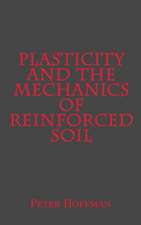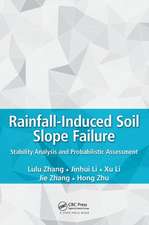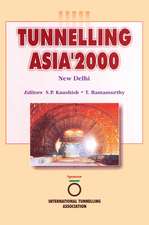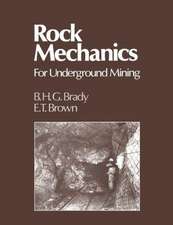Geotechnics of Soft Soils: Focus on Ground Improvement: Proceedings of the 2nd International Workshop held in Glasgow, Scotland, 3 - 5 September 2008
Editat de Minna Karstunen, Martino Leonien Limba Engleză Hardback – 25 aug 2008
Since 2000 increased computer power has made systematic numerical studies utilising the 3D finite element method more and more possible. This enabled the investigation of complex soil-structure interaction mechanisms associated with ground improvement problems. The EC-funded Research Training Network ‘Soft Clay Modelling for Engineering Practice (SCMEP), was set up to develop improved constitutive and numerical models to assist in geotechnical design on soft clays, and made significant advances in theory backed up with substantial experimental programmes (2000-2004). The EC-funded Marie Curie Research Training Network AMGISS (Advanced Modelling of Ground Improvement on Soft Soils) continued the research by the SCMEP network, focussing on modelling ground improvement systems. The aim of the AMGISS network is to develop advanced numerical modelling techniques for analysing the coupled hydro-mechanical behaviour of ground improvement systems on soft soils utilising advanced constitutive modelling, physical modelling and 2D, enhanced 2D and 3D numerical modelling techniques.
The motivation of the 2nd International Workshop on Geotechnics of Soft Soils, organised by the AMGISS network (3-5 September 2008, Glasgow, Scotland), was to bring together practitioners and academics to discuss recent developments in soft soil modelling, focussing on ground improvement. This volume is a collection of papers from the workshop, and discusses the state-of-the-art in soft soil modelling and design, with particular emphasis on ground improvement applications, involving contibutions both from academia and industry. The topics included cover: Modelling (constitutive modelling, numerical modelling, and physical modelling), Design and Application (focusing mainly on embankments and foundations), and Ground Improvement (preloading and consolidation methods, column methods, piles and micropiles, and other ground improvement methods).
Geotechnics of Soft Soils - Focus on Ground Improvement will prove to be invaluable to research students, academics and practitioners, working in geotechnical design on soft soils.
Preț: 1247.16 lei
Preț vechi: 1749.12 lei
-29% Nou
Puncte Express: 1871
Preț estimativ în valută:
238.68€ • 248.26$ • 197.04£
238.68€ • 248.26$ • 197.04£
Carte tipărită la comandă
Livrare economică 14-28 aprilie
Preluare comenzi: 021 569.72.76
Specificații
ISBN-13: 9780415475914
ISBN-10: 0415475910
Pagini: 456
Dimensiuni: 174 x 246 x 34 mm
Greutate: 1 kg
Ediția:1
Editura: CRC Press
Colecția CRC Press
ISBN-10: 0415475910
Pagini: 456
Dimensiuni: 174 x 246 x 34 mm
Greutate: 1 kg
Ediția:1
Editura: CRC Press
Colecția CRC Press
Cuprins
Selected Contents: Preface; Organisers and sponsors; Keynote papers; Constitutive and numerical modelling; In situ and laboratory testing; Design methods; Case studies
Descriere
This volume is a collection of papers from the Second International Workshop on Geotechnics of Soft Soils, which was organized by the AMGISS network. It discusses the state-of-the-art in soft soil modeling and design, emphasizing ground improvement applications. With contributions from academia and industry, the book covers different types of modeling, including constitutive, numerical, and physical; design and application (focusing mainly on embankments and foundations); and ground improvement, with sections on preloading and consolidation methods, column methods, piles and micropiles, and other ground improvement techniques.






